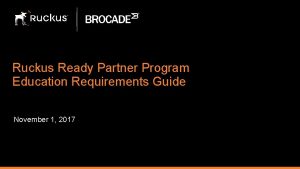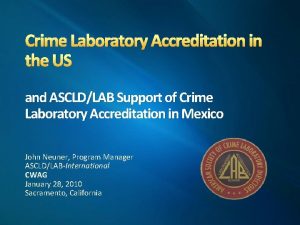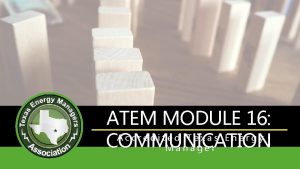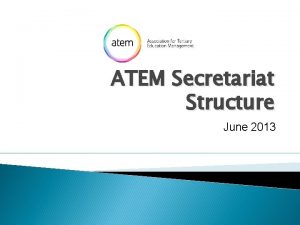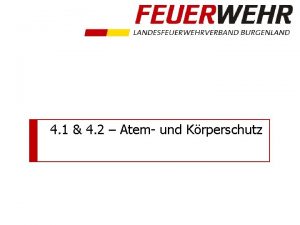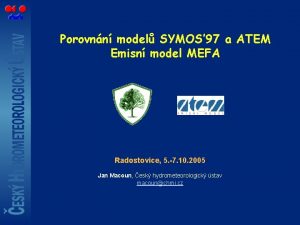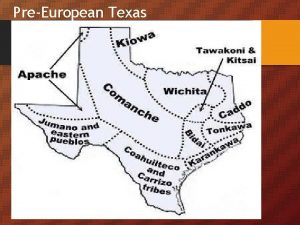ATEM MODULE 10 M Accredited Texas Energy M




















- Slides: 20

ATEM MODULE 10: M Accredited Texas Energy M& a n a. V ger

Outline �Introduction �M&V Steps �Step 1: Define the Baseline �Step 2: Develop an M&V Plan �Step 3: Commissioning (Cx) �Step 4: Post Installation Verification �Step 5: Continual Performance Verification �Review and Discussion �Review Questions Accredited Texas Energy Manager

Introduction �International Performance Measurement & Verification Protocol �Initially sponsored by DOE �Now is managed by Efficiency Valuation Organization (EVO) �Non-profit corporation dedicated to provide guidance for the practice of measuring, computing, and reporting savings from energy and water projects �Measurement & Verification (M&V): the process of using measurements to reliably determine actual savings created within an individual facility by an energy management program (IPMVP) Accredited Texas Energy Manager

M&V Steps �Before Project Implementation - Step 1: Define the Baseline - Step 2: Develop an M&V Plan �After Project Implementation - Step 3: Commissioning (Cx) - Step 4: Post Installation Verification - Step 5: Continual Performance Verification Accredited Texas Energy Manager

Step 1: Define the Baseline Since energy savings must be determined by comparing energy use before � and after a retrofit, the proper documentation of the pre-retrofit or baseline conditions is critical. If this information is not documented, it is lost. It cannot be determined after installation. Accredited Texas Energy Manager

Step 1: Define the Baseline Energy Savings is based two main factors: � - Improved Performance (k. W) - Reduced Operating Usage Accredited Texas Energy Manager

Step 1: Define the Baseline Verifying Savings: � �In a “Perfect World” - Energy Savings = Use. Baseline – Use. Post-Retrofit �In the “Real World” - Energy Savings = (Use. Baseline +/- Adjustment) – Use. Post-Retrofit Variances in Baseline Conditions (e. g. weather, operating hours, equipment performance, repairs, etc. ) Accredited Texas Energy Manager

Step 1: Define the Baseline There are many factors that influence the baseline � - Weather - Operating Hours and Equipment Usage - Performance - User Participation - O&M Measures - Equipment Repairs - Energy Rates �Why Adjust the Baseline? Accredited Texas Energy Manager

Step 1: Define the Baseline Accredited Texas Energy Manager

Step 1: Define the Baseline Documenting Baseline Conditions � �Performance - Existing equipment performance - Spot metering - Current M&O Procedures - Who will be responsible for maintenance �Usage - Existing operating hours - Equipment operating schedules (e. g. temp settings, runtimes) - Increased building loads - Building additions & renovations - Weather Accredited Texas Energy Manager

Step 2: Develop an M&V Plan The Importance of a good M&V Plan � - Accurately assess energy savings for a project - Reduce uncertainties to reasonable levels - Allow for future adjustments, as needed - Monitor equipment performance - Find additional savings - Improve Operations and Maintenance (O&M) - Verify cost savings guarantee is met (Performance Contracting) - Allocate risks to the appropriate parties (Performance Contracting) Accredited Texas Energy Manager

Step 2: Develop an M&V Plan The Site Specific M&V Plan includes: � - What will be done (and when) - Will a census or sampling of measures be taken - How will performance be verified (IPMVP Option, sampling plan, etc. ) - Who will conduct these activities (and when) - How will savings be calculated - How will performance be adjusted to account for varying conditions Accredited Texas Energy Manager

Step 2: Develop an M&V Plan The M&V Plan should address the following: � - What will be measured? - What will not be measured? - How will the owner be protected? - How will the contractor prove performance? Accredited Texas Energy Manager

Step 2: Develop an M&V Plan M&V Options How savings are calculated Option A: Based on measured equipment performance, measured or stipulated operation factors, and annual verification of ‘potential to perform’ Engineering calculations Option B: Based on periodic or continuous measurements taken throughout the term of the Engineering calculations, using measured data contract at the device or system level Option C: Based on whole-building or facility level utility meter or sub-metered data, adjusted Analysis of utility meter data for weather and/or other factors Option D: Based on computer simulation of building or process; simulation is calibrated with measured data Accredited Texas Energy Manager Comparing different model (NOT AN APPROVED METHOD UNDER TEXAS PC GUIDELINES)

Step 3: Commissioning �Commissioning is the process of making a project or measure work �Hardware installation alone does not ensure properation- many projects require calibration, programming, and adjustment after installation �In some cases, this process is more important than the hardware itself Accredited Texas Energy Manager

Step 4: Post-Installation Verification The contractor submits the Post-Installation M&V Report after the project � has been installed and commissioned. It includes: - Project description - List of installed equipment (as-built) - Performance measurements - Expected savings for the first year Accredited Texas Energy Manager

Step 5: Continual Performance Verification The contractor submits Annual Performance Reports to demonstrate that � savings have occurred. They should include: - Project description - Performance measurements - Realized savings for the year - Comparison to the guaranteed amounts Accredited Texas Energy Manager

Review and Discussion �Benefits from an energy retrofit project are only known after project implementation �The M&V is critical when undergoing a Performance Contract �Savings guarantees are only as good as the M&V supporting them Accredited Texas Energy Manager

questions Ashley Williams, MCRP & ATEM �Texas Energy Managers Association �Director of Curriculum and Certification �awilliams@texasema. org Texas Energy Managers Association �www. texasema. org energy management program: fundamentals and

 Is uc berkeley extension accredited
Is uc berkeley extension accredited Www.teta.org.za application form 2020
Www.teta.org.za application form 2020 Ruckus certified partner
Ruckus certified partner Esma accredited laboratories
Esma accredited laboratories Continuing professional development act of 2016:
Continuing professional development act of 2016: Is old dominion university accredited
Is old dominion university accredited Aapl accredited schools
Aapl accredited schools Naacls accredited cytogenetics education program
Naacls accredited cytogenetics education program Bosch learning academy
Bosch learning academy What is oshs?
What is oshs? Accredited organization
Accredited organization What does naeyc accreditation mean
What does naeyc accreditation mean Ascld accredited laboratories
Ascld accredited laboratories Gil fried
Gil fried C device module module 1
C device module module 1 Energy energy transfer and general energy analysis
Energy energy transfer and general energy analysis Energy energy transfer and general energy analysis
Energy energy transfer and general energy analysis Wind energy module e
Wind energy module e Section 2 describing energy (continued)
Section 2 describing energy (continued) Define kinetic energy
Define kinetic energy Primary energy and secondary energy
Primary energy and secondary energy


